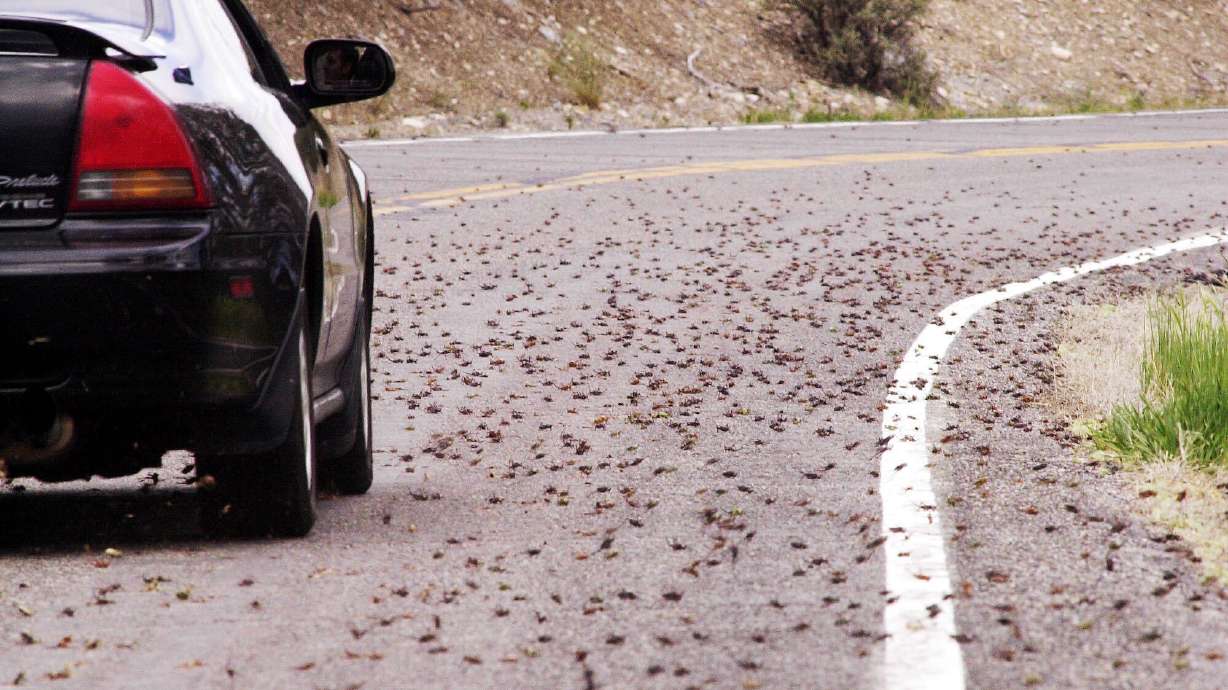Estimated read time: 4-5 minutes
This archived news story is available only for your personal, non-commercial use. Information in the story may be outdated or superseded by additional information. Reading or replaying the story in its archived form does not constitute a republication of the story.
SALT LAKE CITY — Sludge from Mormon crickets has wreaked havoc on Nevada roadways.
The Eureka County Sheriff's Office said on social media that city agencies and the Nevada State Police had to respond to multiple crashes on the highway due to the combination of rain and Mormon crickets.
"Mormon crickets and rain make roadways extremely slick and unpredictable for stopping distance," said the sheriff's office in a release. Crushed crickets leave a sludge that makes the road slick and slippery.
James Gear, who drove from Utah through Ely and Eureka, Nevada, told NBC4 he encountered many crickets on his drive.
"U.S. 50 is covered in this crickets," said Gear. "We didn't know what they were. The roads are brown. I don't think I have any left on the truck, but the trailer is covered in these ground crickets."
Mormon crickets — technically, shield backed katydids — aren't true crickets. They're about 1 or 2 inches long and cannot fly. These bugs tend to live in Western states where there's lots of sagebrush and can travel up to 50 miles in a single season.

The Nevada Department of Agriculture put out a notice on April 18 encouraging the public to report sightings to the department. The department is trying to treat areas with lots of crickets, which it can only do once per year.
"The actions we take now greatly reduce the options available to us later," said Jeff Knight, state entomologist, in a release. "The Mormon crickets are less likely to be affected by baits or sprays right now. If we treat now, and they are not as impacted as we'd like, we won't be able to do it again."
The first cricket sighting of the year was reported in Elko County. Mormon crickets are also present in Washoe, Pershing, Churchill, Humboldt, Lander, Eureka and White Pine counties.
Last year, the north-central city of Elko experienced a swarm of Mormon crickets that one resident described as "almost like a biblical plague." With crickets scurrying all over town, hospitals had to send officials out with leaf blowers and even a tractor with a snowplow in order to move the crickets out of the way.
In addition to Mormon crickets causing trouble on roadways, they pose problems for agriculture. Swarms of crickets can devour fields of crops. Oregon has also had issues with Mormon crickets and announced the Mormon Cricket Suppression Program in 2022 to devote more than $4 million to halt the cricket outbreak.
Spring Creek, which is around 10 miles southeast of Elko, has also had Mormon cricket issues this year.
One decadeslong resident, Gary Doherty, told ABC4 that crickets latched onto the side of his house.
"You couldn't even open up the door, or else you'd be flooded with crickets," said Doherty, who explained to the outlet he had tried for an hour to blow away the crickets with a Shop-Vac. Jonathon Sharp and Kade Garner wrote for ABC4 that Utah has seen reports of Mormon crickets in Box Elder and Uintah counties.
Some, including Charles MacVean, have a brighter view of Mormon crickets.
"It appears, then, that the reputation that Mormon crickets have earned as 'predators of the range' stems more from inaccuracies in the literature and historical legend than from current facts" wrote MacVean. "We must remember that these insects are native to North American rangelands and have coexisted successfully with range plants for centuries."
MacVean said droughts and overgrazing are the instances where crickets and livestock have to compete for food sources.
Mormon crickets get their name from an incident in 1848 — more specifically, the cricket war of 1848, as the Deseret News referred to it in a 1855 article.
Latter-day Saint pioneers arrived in the Salt Lake Valley on July 22, 1847, after they fled from religious persecution, and soon began planting crops. Crickets scurried in and started to devour the crops — then there was also a frost.
Pioneer Eliza R. Snow reportedly said, "This morning's frost in unison with the ravages of the crickets for a few days past produces many sighs, and occasionally some long faces."
At the time, fellow pioneer William Clayton reportedly commented, "The ground seems literally alive with very large black crickets crawling around up grass and bushes."
But then there was the "Miracle of the Gulls."
As the story goes, the pioneers prayed for the crickets to leave and seagulls swooped in to get rid of the crickets. This miracle is, in part, responsible for the seagull imagery in downtown Salt Lake City and for the California gull being an official symbol of the state.
Mormon crickets got their name in relation to this incident.








